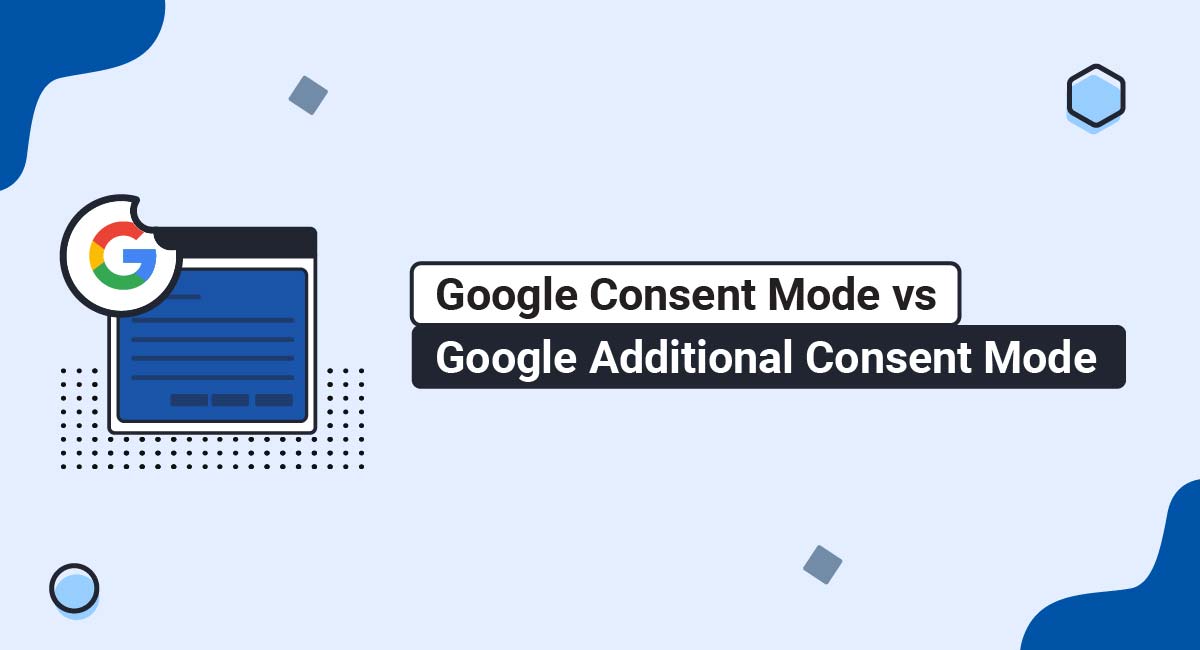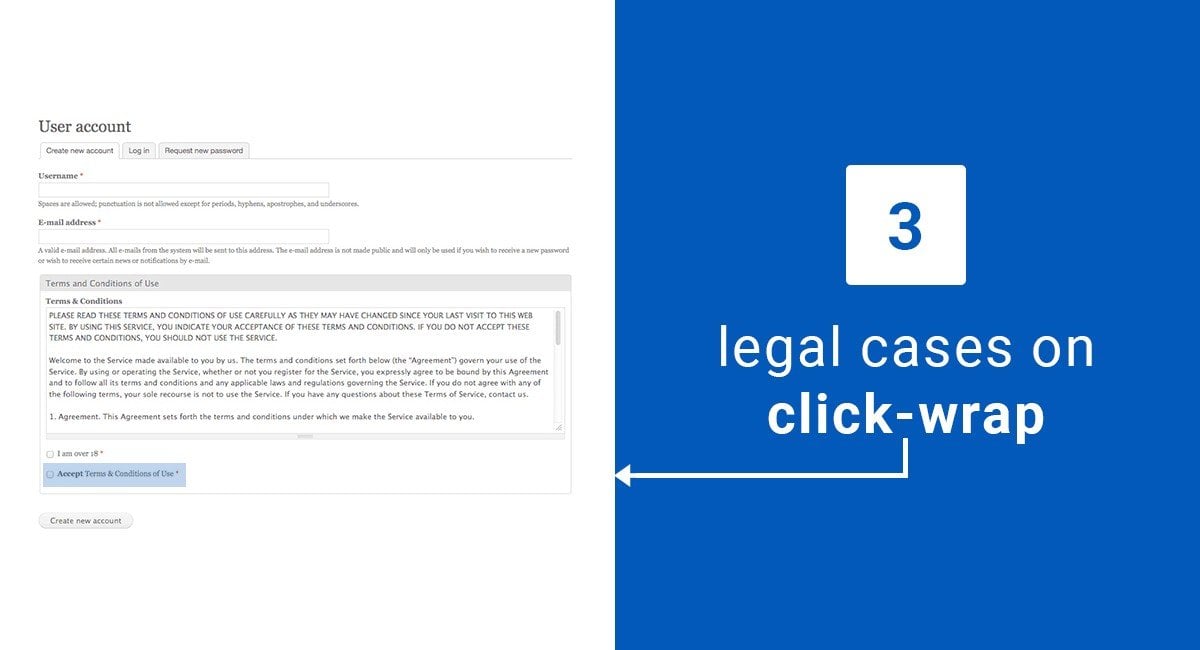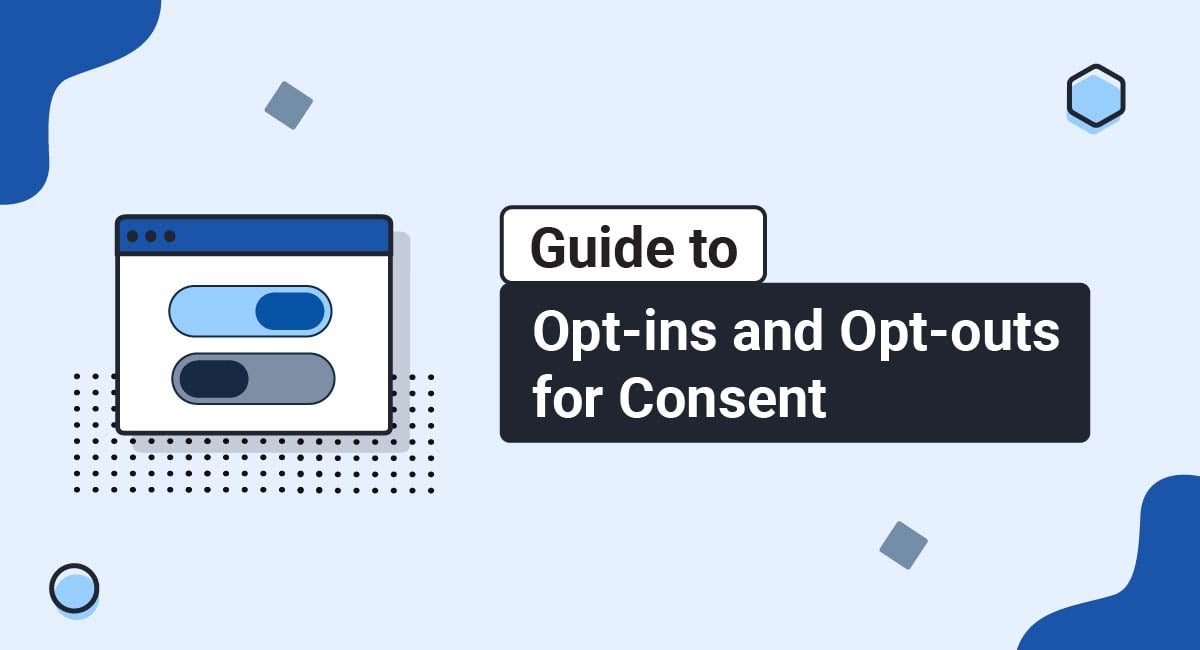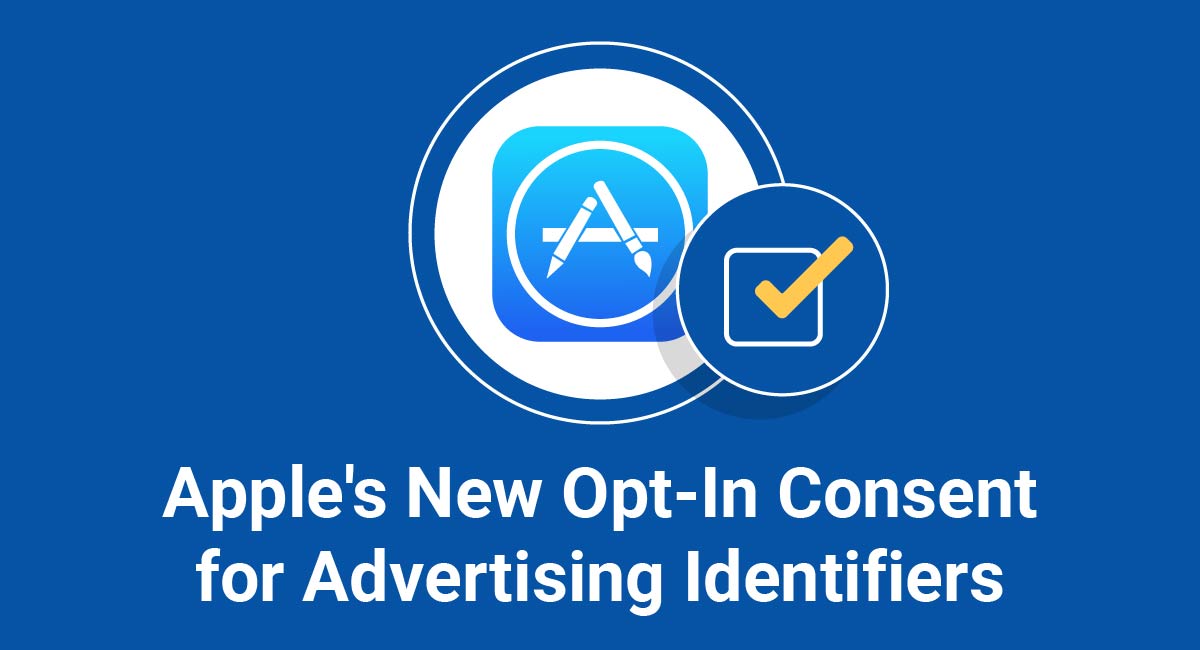Google Consent Mode and Google Additional Consent Mode are two important privacy settings in Google's ecosystem. They're designed to help Google and its users align their consent practices with the requirements of EU privacy and consumer protection laws.
Though they sound similar, Consent Mode and Additional Consent Mode are separate technical specifications that serve entirely different purposes.
This article compares both consent modes, looking at what each entails, who is required to set them up, and how they differ to help inform your compliance efforts.
In November 2023, Google released Consent Mode V2, a new way for businesses to communicate EEA and UK users' consent choices regarding the use of their personal data for advertising purposes to Google.
To comply with the new requirement, you'll need to implement Consent Mode V2 by March 2024. We've updated our Free Cookie Consent to work with Google Consent Mode V2.
Here's how you can integrate our Free Cookie Consent with the new Consent Mode V2:
-
Create the gtag function with the default consent states as denied:
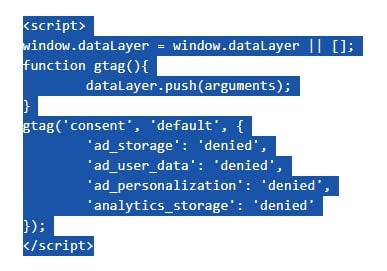
-
Load the Google Analytics/Tag Manager script:

-
Communicate user consent status using Cookie Consent callbacks:
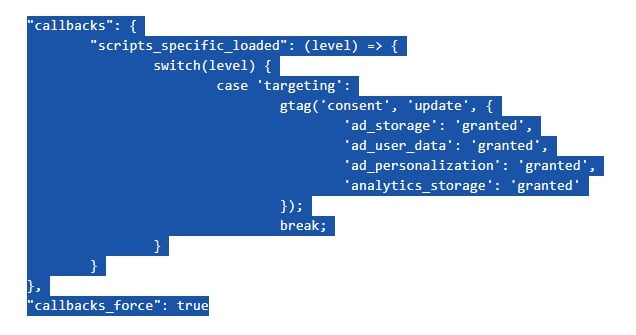
These instructions can be found on our Cookie Consent & Google Consent Mode V2 page. We also have a video walkthrough on how to integrate a cookie notice banner with Consent Mode V2.
- 1. What is Google Consent Mode?
- 2. How Does Google Consent Mode Work?
- 3. Basic Consent Mode vs. Advanced Consent Mode
- 3.1. Basic Consent Mode
- 3.2. Advanced Consent Mode
- 4. Why was Google Consent Mode Introduced?
- 5. Who Must Implement Google Consent Mode?
- 6. What is Google Additional Consent Mode?
- 6.1. What is the IAB Europe's Transparency and Consent Framework (TCF)?
- 7. How Does Google Additional Consent Mode Work?
- 8. Who Must Implement Google Additional Consent Mode?
- 9. What are the Differences Between Google Consent Mode and Google Additional Consent Mode?
- 10. What are the Similarities Between Google Consent Mode and Google Additional Consent Mode?
- 11. Summary
What is Google Consent Mode?
Google Consent Mode is a privacy setting that's available through supported Consent Management Platforms (CMPs) or via manual configuration on a cookie consent banner. Consent Mode is designed for websites and apps that use the following Google services:
- Google tag
- Google Ads (including Google Ads Conversion Tracking and Remarketing)
- Google Analytics
- Floodlight
- Conversion Linker
Once activated, Consent Mode lets you notify Google about your users' consent choices for cookies or similar trackers - particularly for analytics and advertising.
This way, when a user visits your website/app and interacts with your cookie consent banner (i.e., accept or reject cookies), Google tags note and respect users' choices.
Here's how Google explains Consent Mode:
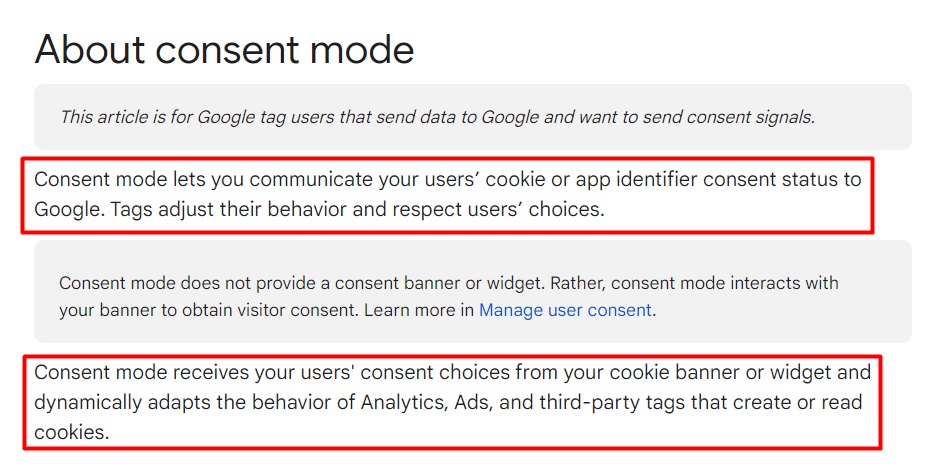
Note that Consent Mode doesn't provide a CMP or cookie consent banner. Instead, it works with your existing cookie consent banner to adjust Google tags based on users' consent choices.
Google first introduced Consent Mode in 2020, with its latest version - Consent Mode v2 - released in November 2023. The deadline for switching to Consent Mode v2 was March 2024.
How Does Google Consent Mode Work?
To control the behavior of cookies and tags, Google Consent Mode previously used only two consent signals: ad_storage and analytics_storage.
With Consent Mode v2, Google increased its consent signals to four by introducing two additional consent signals: ad_user_data and ad_ personalization.
Here's how Google sets out each consent type and their functions:
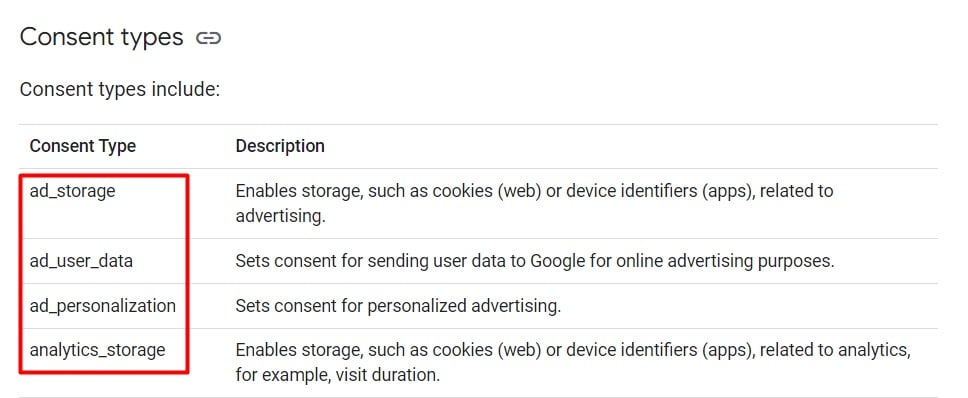
When Consent Mode is enabled, these signals send users' consent choices to Google through your cookie consent banner.
At this point, one of two things occur:
- When users accept cookies, Google collects data (which can include personal data) as described in your Cookies Policy
- When users reject cookies, Google doesn't collect any personal data but uses conversion and/or behavioral modeling to bridge the gaps in your data
Keep in mind that Consent Mode is only applicable to Google services. This means it doesn't adjust the behavior of other third-party advertising or analytics scripts.
Basic Consent Mode vs. Advanced Consent Mode
Thanks to its latest version (Consent Mode v2), Consent Mode now lets websites and apps implement its settings in one of two ways: Basic or Advanced.
Basic Consent Mode
Basic Consent Mode is a "no data until consent" approach. In other words, Google's tags and scripts won't load on your website/app until a visitor interacts with your cookie consent banner.
If users accept ads or analytics cookies, Google collects data as usual. If they decline, Google doesn't receive any data about users or their consent status. But to compensate for the loss of data, Google uses general conversion modeling to fill in the gaps.
Advanced Consent Mode
Advanced Consent Mode lets Google's tags load once someone visits your website or app - even before they interact with your cookie consent banner.
That said, the default consent state is set to "denied" (unless you set your own default) and only gets updated when the visitor makes a consent choice.
If they accept cookies, Google collects data normally. If they decline, Consent Mode sends cookieless pings to Google for more accurate, advertiser-specific modeling. These pings contain aggregate or non-identifying data such as:
- Timestamp
- Location (country)
- Indications of ad-clicks
- Browser and device type
- Consent and conversion status
- Boolean data about consent state
With these data, you still get useful insights about your ad effectiveness and website/app performance when users reject cookies. For this reason, Advanced Consent Mode is considered the better model.
Here's how Google breaks down the differences between Basic and Advanced Consent Mode:
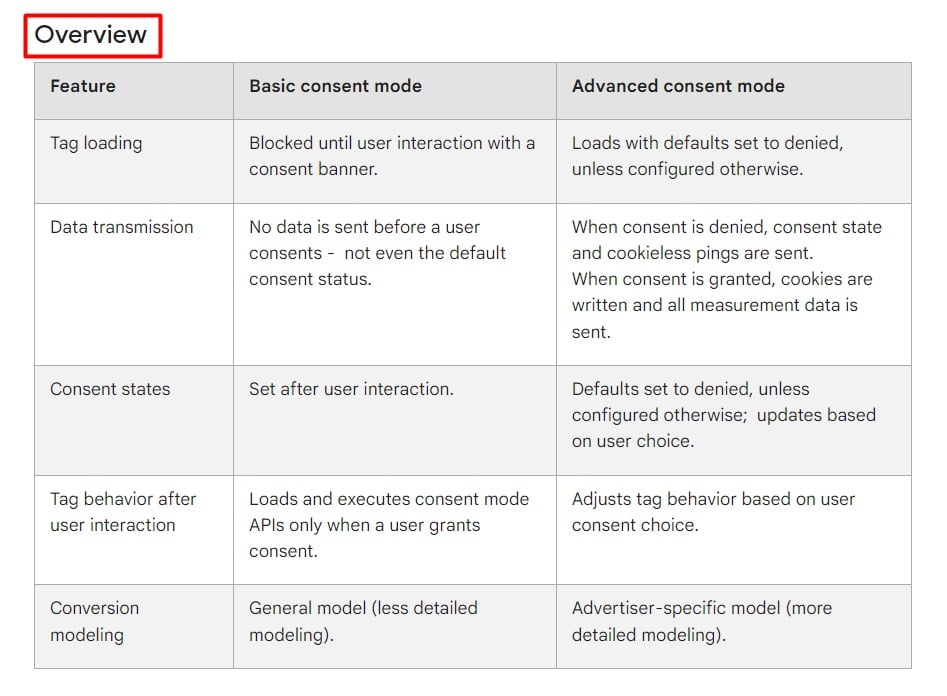
Why was Google Consent Mode Introduced?
Google Consent Mode was introduced to help Google and its users comply more easily with the legal requirements of three key laws:
- The EU's General Data Protection Regulation (GDPR)
- The ePrivacy Directive (also known as the EU Cookie Law)
- The EU Digital Markets Act (DMA)
Because users nowadays prefer to decline non-essential cookies, Consent Mode works to get additional signals from non-consenting users without violating their privacy.
This means websites and apps using Google services get anonymized data so they don't completely miss out on services like analytics and advertising.
Who Must Implement Google Consent Mode?
As of March 2024, websites and apps that use Google services like Ads, Analytics, or Floodlight and collect data from EU/EEA users must implement Consent Mode v2.
At a minimum, Google requires that you implement Basic Consent Mode whereas Advanced Consent Mode remains optional.
This requirement reflects Google's efforts to align its EU User Consent Policy with the requirements of EU privacy laws.
Failing to set up Consent Mode v2 means you will no longer receive data about new EU/EEA users from services like Google Analytics 4 and Google Ads.
What is Google Additional Consent Mode?
Google Additional Consent Mode is a technical specification for Google's advertising services. It was created to be used alongside IAB Europe's TCF v2.2 (Interactive Advertising Bureau Europe Transparency and Consent Framework).
In other words, Google Additional Consent Mode is only relevant to you if your website/app implements the IAB Europe's TCF v2.2.
Additional Consent Mode is only available by using a Consent Management Platform (CMP) registered with IAB Europe's TCF. You can find the complete list of Google-certified CMPs here.
Once activated, Additional Consent Mode lets you send consent signals to ad vendors who are part of Google's Ad Tech Providers (ATP) list but aren't yet registered on the IAB Europe's Global Vendor List (GVL).
Here's how Google explains this:
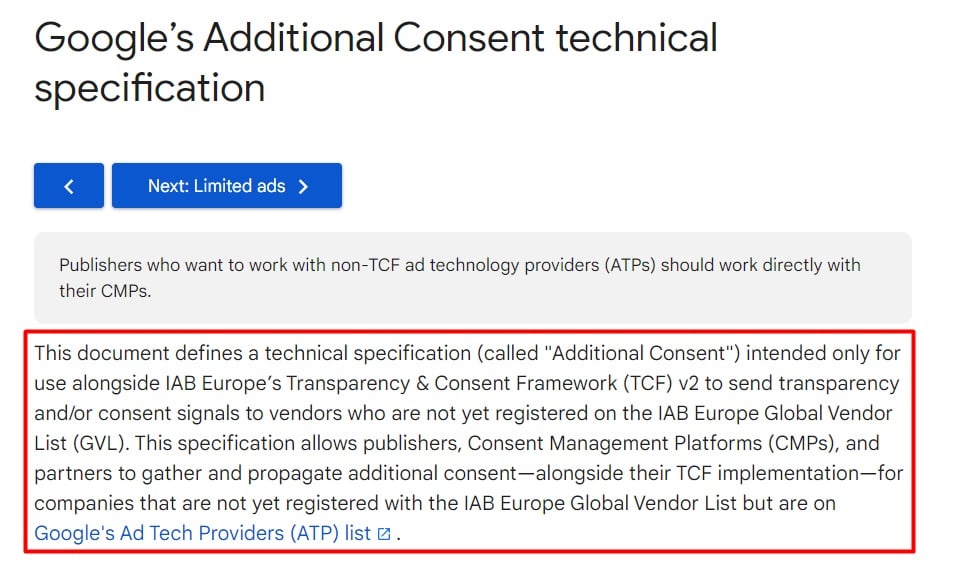
With Additional Consent Mode, Google essentially expands the pool of ad vendors you (as a publisher) can partner with to include non-TCF-certified players.
In other words, it presents an opportunity to potentially increase ad revenue (by providing a bigger playing field) while respecting users' privacy and consent choices.
What is the IAB Europe's Transparency and Consent Framework (TCF)?
IAB Europe is an association created to help the European online advertising industry navigate compliance with laws like the GDPR and ePrivacy Directive.
To support this goal, IAB Europe introduced the Transparency and Consent Framework (TCF) - a voluntary accountability tool designed to standardize how businesses obtain consent for advertising purposes.
To keep things simple, here are the relevant highlights where the TCF and Google are concerned:
- The IAB Europe's TCF is regularly updated, with the current version being TCF v2.2
- In August 2020, Google integrated its ads system with IAB Europe's TCF
- Google is actively encouraging its ad vendors to join the TCF and become part of IAB Europe's Global Vendor List
- To become a TCF-compliant publisher, you must first use a TCF-compliant CMP and then enable TCF v2.2 settings in your cookie consent banner
How Does Google Additional Consent Mode Work?
When a website/app implements the IAB Europe's TCF, a "Transparency and Consent String" or "TC string" is generated for the technical implementation.
In the case of Additional Consent Mode, Google has introduced an "Additional Consent String" or "AC string" that houses a list of Google Ad Tech Providers (ATPs) who are not registered with IAB.
According to Google, Additional Consent Mode works by supporting both the standard TC string and the AC string:

It's also worth noting that only CMPs registered with IAB Europe's TCF can generate AC strings. No publisher, vendor, or third party is allowed to do so:

Who Must Implement Google Additional Consent Mode?
Google requires you to use a Google-certified CMP that supports IAB Europe's TCF v2.2 and Additional Consent Mode if all of the following is true:
- You want to serve ads to EEA or UK users
- You want to partner with non-TCF-certified vendors on Google's ATP list
-
Your website/app uses the following Google ad services:
- Google AdMob
- Google AdSense
- Google Ad Manager
This requirement has been in effect since January 16, 2024.
What are the Differences Between Google Consent Mode and Google Additional Consent Mode?
To recap, here's a quick rundown of the key differences between Google Consent Mode and Google Additional Consent Mode:
| Key Areas | Google Consent Mode | Google Additional Consent Mode |
| Purpose | Help Google and its users comply with the consent requirements of laws like the GDPR and DMA without sacrificing advertising and analytics services | Expand the pool of ad vendors available to websites to include those on Google's ATP list who aren't part of the IAB's list |
| Applies to | Websites and apps that use Google advertising and analytics services | Websites and apps (also known as publishers) that implement IAB Europe's TCF v2.2 |
| How it works | Uses Google tags to send users' consent choices for advertising and analytics cookies to Google | Generates an "Additional Consent String" that contains information about Google's ATPs to support the existing "Transparency & Consent string" |
| Implementation | Through Consent Management Platforms (CMPs) or via manual configuration on a cookie consent banner | Through Google-certified CMPs registered with the IAB Europe's TCF v2.2 |
| Relevant Google Services | Google tag, Google Analytics 4, Google Ads, Floodlight, and Conversion Linker | Google AdMob, Google AdSense, and Google Ad Manager |
What are the Similarities Between Google Consent Mode and Google Additional Consent Mode?
Despite being created for separate purposes, Google Consent Mode and Google Additional Consent Mode share some basic principles:
- Both settings give websites and apps more functionality to work with on Google's ecosystem without violating user privacy under laws like the GDPR
- Both settings are designed specifically for websites and apps that cater to users in the EEA or UK
- Both settings can be implemented by using a Google-certified CMP
- Both settings work by sending consent signals using Google tags and scripts
Summary
Google Consent Mode and Google Additional Consent Mode are distinct privacy settings on Google's ecosystem that serve different purposes.
Google Consent Mode helps you manage your EEA/UK user consent choices for Google services (Analytics, Ads) while complying with laws like the GDPR and ePrivacy Directive.
Consent Mode gives you two implementation options:
- Basic Mode doesn't collect any data from users until they accept cookies via your website's cookie consent banner. It uses general conversion modeling to compensate you when users don't accept cookies.
- Advanced Mode uses cookieless pings to collect aggregate, non-identifying data from non-consenting users for more accurate modeling.
Google's Additional Consent Mode, on the other hand, is specifically designed for websites and apps using the IAB's Transparency and Consent Framework (TCF).
It works by letting approved CMPs generate an "Additional Consent String" to give you access to vendors on Google's Ad Tech Providers list who aren't part of the TCF's vendor list.
This expanded vendor pool means potential revenue growth from Google's ad services while respecting user privacy under TCF's standards.

Comprehensive compliance starts with a Privacy Policy.
Comply with the law with our agreements, policies, and consent banners. Everything is included.
